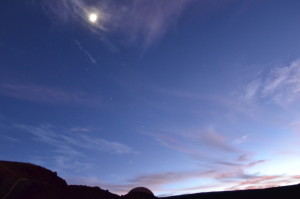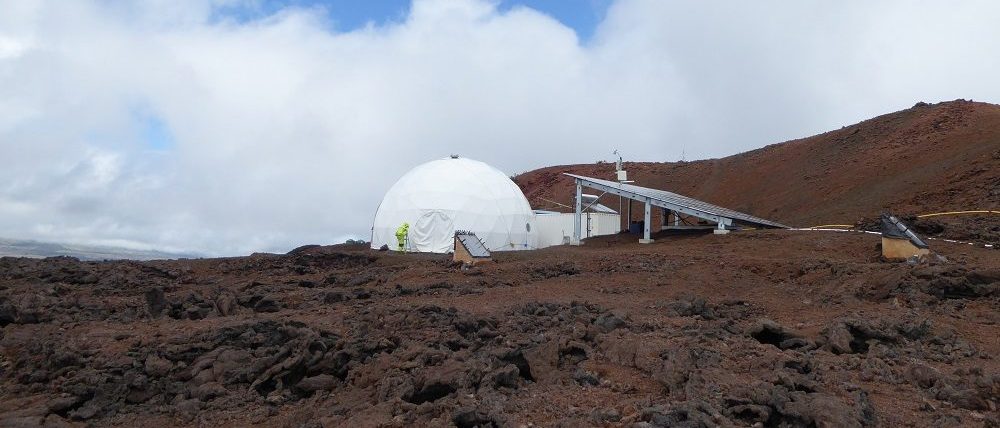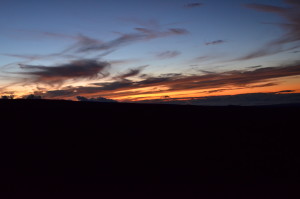At around 4 pm local time about two months ago, six acquaintances entered a dome-on-a-volcano and NASA’s longest Mars simulation began.
![]() For our 1st-month-i-versary in the dome, we all wrote blog posts. The theme was: What I learned in my first month on sMars. For this month we came up with another theme: What’s the most challenging, and most rewarding, part of being on sMars? Answering this month’s topic required taking a step back. And then, another. Then….there was some hopscotch involved.
For our 1st-month-i-versary in the dome, we all wrote blog posts. The theme was: What I learned in my first month on sMars. For this month we came up with another theme: What’s the most challenging, and most rewarding, part of being on sMars? Answering this month’s topic required taking a step back. And then, another. Then….there was some hopscotch involved.
 The first step was simple: a short step-to-the-right over our lack of social media and open internet. lack of social media and the open internet. Silly right? The internet is a normal part of everyday life back home. While most of us depend on it more than we’d like to admit, the crew learned rather quickly to get along without it. For now, automated posting (i.e. Buffer) and information feeds via ground support are filling in. To boot, we all notice that we get way more stuff done.
The first step was simple: a short step-to-the-right over our lack of social media and open internet. lack of social media and the open internet. Silly right? The internet is a normal part of everyday life back home. While most of us depend on it more than we’d like to admit, the crew learned rather quickly to get along without it. For now, automated posting (i.e. Buffer) and information feeds via ground support are filling in. To boot, we all notice that we get way more stuff done.
The next step was a little longer. And, wider. In fact, it was like leaping over one of those speed humps. Not the little topes that wreck your axles and jiggle your skull like a dashboard bobblehead. The kind that can only be surmounted on foot with a running start, on a street bike with a lots of “weeeee!”, and, of course, in a 1969 Dodge Charger painted orange at the beginning of certain 70’s shows. The word for these big guys in Spanish is “Giba”. For me, the giba was power. With our hydrogen fuel cells down, and no alarm system in place to tell us when to turn on the backup backup generator, we only have as much power as we make with whatever sunlight we have that day. So, after a certain time, which could be 2 pm or 5 pm, LEDs in the biolab switch off (poor plants!), devices stop charging, and cooking is banished until further notice.
This isn’t a problem when it happens at 5 pm, or even 4:30 pm. It can be an issue when, like tod ay, we had to kiss our precious plans for crepes on our 2nd-month-i-versary goodbye. But – here’s the thing – unlike Antarctica in winter, the sun really will come out tomorrow. And when it does, our plants will get light, laptops will get charged, and the French guy will make us crepes. (Right, Cypi? Ricotta and thyme on mine, please…) What bothers me is not so much the lack of power at certain times, but the lack of an alarm system to warn us about the lack of power at any time. That being said, we’re working on it.
ay, we had to kiss our precious plans for crepes on our 2nd-month-i-versary goodbye. But – here’s the thing – unlike Antarctica in winter, the sun really will come out tomorrow. And when it does, our plants will get light, laptops will get charged, and the French guy will make us crepes. (Right, Cypi? Ricotta and thyme on mine, please…) What bothers me is not so much the lack of power at certain times, but the lack of an alarm system to warn us about the lack of power at any time. That being said, we’re working on it.
That thought led to me what I believed, at least at first, was the final step. In the last 48 days, a somewhat grating trend has emerged. Every day when I wake up there is a special sort of email lying in wait. In this email, someone is asking a question or making a request. This request makes it clear that, to the world outside, the facts of our existence are thoroughly mysterious. To be fair, more often than not, it’s a well-meaning media inquiry or an innocent outreach attempt.
Media/outreach: How does it feel to be cramped in a small dome with each other? How does it feel to be so isolated?
sMars Crew: We have more living space per person here than the average apartment-dweller in any of the five largest US cities. We also have dinner together every night, plus two movie-nights and two dance classes per week. So…they kind of cancel each other out?
Media/outreach: How does it feel to not have fresh food for a year?
sMars Crew: Um. (Looking over at plants, bread, and giant tubs of cultured cheese) Have this picture of our yogurt.
Once in a while the email is from ground control. In it, they are asking us to do something that seems quite reasonable from their perspective, but is, in fact, impossible, or, at least, inadvisable. For example:
Mission control: For this command, hit send, leave the lid on the laptop up and the screen on for 20 minutes.
sMars Crew: We cannot do that, Ground Control. We do not have the power.
MC: Say again?
Crew: No power, ground control. Cloudy day on sMars. If the lid must remain open, we can send the command tomorrow, after 8 AM, when the solar cells are charging.
And again:
MC: Put the chemical mix in a spare glass jar with a lid.
Crew: “Spare glass jar” does not exist on sMars. Abort/Retry/Fail?
These interactions – often amusing, occasionally wearying – are not in and of themselves the biggest challenge. They are, however, symptoms of the challenge. Inch by inch, leap by step and jump, we’re getting closer to the big hurdle, the thing that makes hard being up here. Just a few more tiny…. –

The crew of HI-SEAS IV, clockwise from 12-o’clock: Tristan Bassingthwaighte, Sheyna Gifford, Andrzej Stewart, Christaine Heinicke, Cyprien Verseux and Carmel Johnston. Photo design by S. Gifford. Photo by C. Heinicke.
…steps. It would be expedient, and incorrect, to say that the challenge is “communication”: a simple gap between us and the rest of the world. To maintain that, “The world doesn’t understand what our job is,” or “our circumstances are so different that almost no one on Earth can relate,” would be near-sighted at best. Many people have lived, and continue to live, in environments where food, water, and power are ongoing issues. Even more people – in fact, everyone reading these words – can relate to the basic thing we’re doing up here, because everyone, at some point in their lives, has practiced for something: for a job interview, a patient examination, a school play.
What we’re doing is a bit of both, bundled up and served with a heaping helping of mission support. Along with dozens of ground controllers, we’re rehearsing for a real Mars mission in an extreme environment. We’re doing this in much the same way that people practice for track meets, debates, and dance-offs. All over the world, every day, right now, in fact, someone is reciting lines to empty rooms; playing one-sided chess until dawn; running in circles (ellipses, really) over and over again. It’s a little bit weird, but it’s also necessary to win the game, to finish the race, to get to Mars, for the show to go on.

Star Rise Over the Dome
It may not always be clear how we’re practicing up here, but I believe most people understand that we’re rehearsing, as best we can, for an eventual Mars mission. The rest, as they say, is just details – details that we will provide in the months and years to come. No matter how much time passes, though, or how much minutia we disclose in our blogs or during interviews, this much will always be true: ultimately, the most challenging part of the mission is that we’re doing something very, very unique, and therefore very challenging to explain.
It all comes down to numbers. Practicing for a Mars mission of any length is far less frequent than almost anything else a human might pursue as a skill. Ice skating, stamp collecting, card tricks, and early Renaissance poetry are hobbies enjoyed by thousands upon thousands. Living in the dome is a full-time gig, but 24-7 dedication to a vocation is shockingly common. It’s certainly for true doctors, of whom the US alone graduates 25,000 a year. It’s also true for Army Rangers, Navy SEALs, and service people on deployment everywhere. That’s hundreds of thousands of people who share a common experience. Humans who have been on simulated Mars missions number in the bare hundreds. Those who have been on long-duration Mars simulations can be counted in dozens. And the number who have been on a NASA Mars sim for a year…will be six, as of 2016. Five other people in the world will truly know what it was like to make this attempt. Until the next 12-month mission launches (may it be soon) this year will always set us apart in some ways from the rest of humanity.
To everyone else on the planet (hi there!), I am doing my best to make things as clear as I can. Things like: Just how little we can see when we step through the hatch on an EVA. Look up. That’s what sMars looks like to the Go Pro mounted on the outside of my suit. Look down. That video was shot from the INSIDE of the suit. There may be no clouds on real Mars, but to us, sMars is always a bit foggy
To help my colleagues understand my job on this mission, I’m going to “beam” into medical conferences and explain how we prepare for emergencies when there is one doctor, six patients (I could be one too!), and a very large number of things that could go wrong. And, as many times as it takes, I’ll rehash the food situation: the homemade bread and bagels; the cream cheese, pizza, tiramisu, and tacos, topped with rehydrated veggies, and, every so often, fresh veggies. It’s so good I wish I could invite you all over for dinner. Even if I did, though, there would still be this very different thing that I did every day for a year sitting at the table between us.
Making this experience relate-able to [The Population of the World – 5] will be a life-long challenge. To be fair, coming here was not the first time I did something atypical, then spent a lifetime explaining it. When I was 15 I left home and moved to Mexico on an exchange. Then, I went to boarding school. It isn’t easy for people to understand why someone would do that (answer: adventure, change of scene, and family tradition), but it was more palatable by far than my next trick. The following summer, I went to Africa. I witnessed things there, at the beginning of the Ivory Coast’s civil war, that made relating to other 16-year-olds…a challenge, to say the least. For the most part, upon my return, I didn’t try to explain it – the way jungle would be on fire, smoke and flames in the distance; the sound of drums in the night, like a heartbeat coming from every direction; how that night was thick and dense, like living inside somebody’s lung; the way the sky and the Earth and nearly every living thing was pulsing and vibrant and, in its own way, immense; how the children, by contrast, were tiny and frail-looking, yet would run after me shouting and waving, “Bon Soir, Madame! Bon Soir!”
During and after college, I began encountering others who had either lived or worked in Africa. When we met, we talked about jumping over broomsticks at weddings while wearing purple pants; the way the women would glide down the dirt roads with fabric piled on their heads as if it were weightless; the whites of eyes and half-moon smiles that would drift through the otherwise inky evenings. We also talked about the guns, and the grief, and the terrible, reckless loss that overtook that beautiful and complicated country. It took a long time to find these people. By going to Abidjan at the age that I and in the year (1995) that I did wearing my particular skin color, I did something very unusual (and not entirely safe). I have spent the rest of my life trying to explain why I did it, except to those who have been there.
At last we get to the end of heart of the matter, the end of the road. We’ve come to understand that the most challenging part of being on sMars is that, for a while at least, there will be exactly five people on Earth to whom I do not have to explain myself. So what’s the most rewarding part? That, for everyone else, I get to try. I get to spend the rest of my life discussing with everyone who wasn’t here why practicing for space missions is important; why space is a critical part of the human endeavor and the human experience; and how these challenges, as strange as they may seem, have made everyone involved better at living on Earth. It may have set me apart from you, but, in its own strange way, it also gave me access to you. And for that, I am very grateful.
Also, the food here is really good. Seriously. Have a picture. On second thought, have four.





